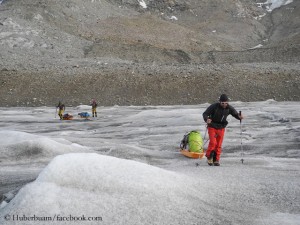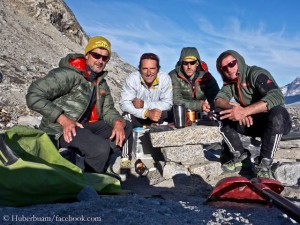East Greenland: Alexander Huber and Co. pluck the day
 Sometimes climate change puts a spoke in adventurer’s wheel. Actually, German top climber Alexander Huber and his teammates from East Tyrol, Mario Walder, Bruno Schneider and Christian Zenz, had planned this summer to free climb the South Face of Tupilak in East Greenland, 16 years after the first ascent. “This is an absolutely awesome, steep wall,” says Alexander. “But we have not even got there. It was impossible to walk 40 to 50 km to the mountain without the use of sledges.” The bare glacier ice without snow cover and the small stones on it had wrecked the Pulkas, the plastic sledges, within only one third of the distance. The four climbers had taken their skis in vain.
Sometimes climate change puts a spoke in adventurer’s wheel. Actually, German top climber Alexander Huber and his teammates from East Tyrol, Mario Walder, Bruno Schneider and Christian Zenz, had planned this summer to free climb the South Face of Tupilak in East Greenland, 16 years after the first ascent. “This is an absolutely awesome, steep wall,” says Alexander. “But we have not even got there. It was impossible to walk 40 to 50 km to the mountain without the use of sledges.” The bare glacier ice without snow cover and the small stones on it had wrecked the Pulkas, the plastic sledges, within only one third of the distance. The four climbers had taken their skis in vain.
Alexander Huber had already visited East Greenland last year, but in another season. “You just cannot imagine in arctic winter that everything is completely free of snow in summer. This shows quite clearly the effect of climate change”, tells me the 47-year-old, the younger of the two Huber brothers. “It’s very unusual that the zero-degree line in Greenland is permanently at a height of 2500 to 3000 meters.”
Attractive alternative destination
Huber and Co. re-planned without further ado and decided upon an attempt on the East Pillar of the 2020-meter-high Ritterknecht, which many climbers know under the Danish name Rytterknægten. The distinctive mountain in the so-called “Schweizerland” (Swiss land) was first climbed in 1938 by an expedition of the “Academic Alpine Club Zurich”. The group led by climber André Roch had scaled more than a dozen peaks in East Greenland for the first time. Alexander had picked up the East Pillar as a possible goal last year. “That was part of the motivation to start the journey. A 1000-meter-high pillar with an impressive massive shape. Of course, it’s an attractive goal for an alpinist to climb such a pillar.” Huber found out that apparently no one had climbed it so far. “We made a first ascent of this pillar, which was a great thing.”
Made what was possible
Within 24 hours the quartet climbed via the pillar to the summit and back to their camp on the glacier. It was “a powerful ascent,” Mario Walder wrote in his expedition report. The climbers called their new route “Carpe diem”, what literally means “Pluck the day”. The motto also applies to the expedition, says Alexander Huber: “We have used and enjoyed our chances. We have just done what was possible and accepted it contendedly.” The climbers were on the way for three weeks. The special attraction of an expedition to the Arctic lies in the “absolute remoteness,” says Alexander. “An Inuit has led us to the end of the fjord. And from that moment we were the only people who were traveling in this mountainous region.”
Vulnerable
Immediately prior to departure from Iceland to Greenland Alexander Huber was informed about the 16-meter fall of his brother Thomas from a rock face in the Berchtesgaden region. “For me this was quite a dramatic moment, because I did not know whether I should set off or not. Before I flew, I wanted to know that he was alright.” Although Thomas – as reported – got off lightly, Alexander was shocked.: “Things like that bring to your mind how vulnerable you are as a human.”
P.S. Alexander Huber has just returned from the rocky mountain massif Picos de Europa in northern Spain. There he and his German climbing partner Fabian Buhl succeeded in free climbing the classic route “Suenos de invierno” (Winter Dreams) on the 2518-meter-high Naranjo de Bulnes for the first time – within nine hours. The Spanish climbers who had done the first ascent of the route in winter 1983 had spent a total of 69 days in the wall.









